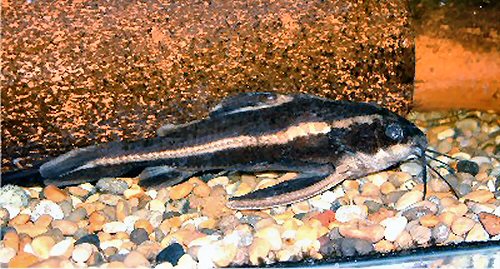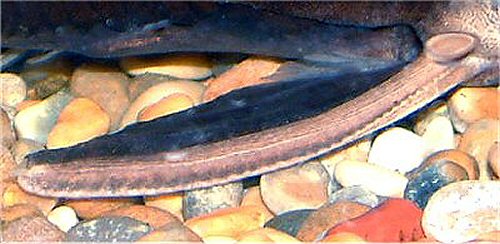Platydoras armatulus (Valenciennes in Cuvier & Valenciennes, 1840) |
| Synonyms: |
| Doras armatulus |
| Common Name: |
| Raphael Catfish, Chocolate Talking Catfish, Humbug Cat |
| Family: |
| Doradidae |
| Subfamily: |
| Doradinae |
| Distribution: |
| South America: Paraguay-Paraná and portions of Amazon and Orinoco basins |
| Size: |
| 20cm (8ins) |
| Temp: |
| 24-30ºC (75-87ºF) |
| pH.: |
| 6.0 - 7.5 |
Update: January 2009. When this factsheet was first compiled in April 2006 we had captioned this Dorad as Platydoras costatus, as this was the name that we knew this catfish as for a great number of years. Due to the work carried out in the paper by Piorski, N.M., J.C. Garavello, M. Arce & M.H. Sabaj Pérez in 2008 we came to realise that the real P.costatus was indeed indigenous to the coastal drainages of Suriname and French Guiana and what we had called for years, P.costatus, was in factPlatydoras armatulus. I will carry on with the original text with references to this. As a footnote there are four species of recognised species of Platydoras: P. armatulus (Paraguay-Paraná and portions of Amazon and Orinoco basins), P. costatus (Corantijn and Maroni basins), P. brachylecis (Rio Mearim, rio Pindaré, rio Itapecuru and rio Parnaíba basins in northeastern Brazil) and P. hancockii (Negro, Essequibo, Demerara, and upper Orinoco basins).
t is now 56 factsheets ago ( no 17) since I ventured into an in-depth look at this months lookalike Dorid partner, Orinocodorus eigenmanni, so basically for this months no 73 effort,Platydoras armatulus, most of the criteria works both ways concerning water parameters and basic husbandry. For a start the common names are alike with eigenmanni having the longer nose hence the Long Nosed Raphael whereas our subject this month is the Raphael Catfish a common name used in North America, however in the U.K. you will hear “Humbug” or “Chocolate Talking Catfish” for this species. In its native Peru it is called in the local Spanish dialogue "Rego rego" meaning something to do with water which maybe our Spanish friends can enlarge upon.
 |
This is one of the nonindigenous catfishes that have been released from the home aquarium into the waters of Florida in the U.S.A. and had been collected in the early 1980s but not as yet established, which must be a relief to the local wildlife authorities but must also anger them to the irresponsible actions of the persons concerned.
This is in my opinion an easy catfish to keep even for the catfish novice as long as you don't intend to show this fish off to your friends as it will just disappear when introduced to your tank and will be forgotten until maybe 'spied' one evening a few months later. It can be extremely nocturnal but strangely enough can be 'trained' when older to come out of its retreat at feeding time as can be seen in the top picture, he/she gets fed around 7.30 every night and as soon as the cover glass is moved it swims out of its pipe and up to the water surface for its rations of either frozen bloodworm, tablets or pellets. When this fish is younger and not often seen it is a good idea to feed after lights out.
You will have to be aware of the pectoral spines in P.armatulus (bottom picture) as they are extremely strong and powerful and you will get a nasty shock, not too mention the pain if you get on the wrong side of these fins. If you have to catch this fish for any means such as moving to another tank or even showing this fish at a show you will have to catch it by either maneuvering it into a glass vessel or the method I use is just to pick the pipe up where it resides and move it (quickly!) to your chosen destination. When young you can even net this fish but when it gets bigger it can get caught in the mesh of the net and apart from having to cut the net to release it you can stress the fish greatly.
 Platydoras armatulus - Pectoral Spine |
In common with most of the Doradidae family it can create a sound by grating its fin bones in each socket and amplifying the noise via the swim bladder which is one reason why it got its common name of the “Chocolate Talking Catfish”
As a footnote this is a fairly easy catfish to keep as long as you can provide it with shelter such as pipes or cave work. It will even jam itself into the pipe with its pectoral spines and will be unremovable.
As a footnote this is a fairly easy catfish to keep as long as you can provide it with shelter such as pipes or cave work. It will even jam itself into the pipe with its pectoral spines and will be unremovable.
| Characteristics |
Dorsal Spine; serrated on both sides, those on the posterior edge smaller, sometimes disappearing with age. Caudal Peduncle; covered above and below with modified caudal fulcra. Maxillary barbels; Extending to tip of humeral process. Eyes; large and laterally placed.
| Colour |
| Compatibility |
| Breeding |
| Feeding |
| Etymology |
| Platydoras: Platys = broad; doras = cuirass. |
| Glossary of Terms |
| Fulcra - Bony plates. Caudal Peduncle - The area between the dorsal fin and the tail. Humeral Process - Bony extension of the pectoral girdle. Scutes - Bony covering |
| References |
Northern Area Catfish Group Information Sheet no. 09.
Froese, R. and D. Pauly. Editors. 2002. FishBase.World Wide Web electronic publication.www.fishbase.org, 20th August 2002
Sabaj, M. and C.J. Ferraris Jr., 2001. Doradidae.. pp. In [Editorial list.]. Checklist of the Freshwater Fishes of South and Central America. In preparation.
Froese, R. and D. Pauly. Editors. 2002. FishBase.World Wide Web electronic publication.www.fishbase.org, 20th August 2002
Sabaj, M. and C.J. Ferraris Jr., 2001. Doradidae.. pp. In [Editorial list.]. Checklist of the Freshwater Fishes of South and Central America. In preparation.
Piorski, N.M., J.C. Garavello, M. Arce & M.H. Sabaj Pérez (2008): Platydoras brachylecis, a new species of thorny catfish (Siluriformes: Doradidae) from northeastern Brazil. Neotropical Ichthyology 6 (3): 481-494
![[uNGu]™](https://blogger.googleusercontent.com/img/b/R29vZ2xl/AVvXsEgrPnhQswWH1n3co_BH9h53yVB4bM90uN-8zYlArwsG5kGjTCPGH7df0Y3uZofyDG2x9zRWH_wjTJ8NDmxsO-H3eYm9EXels8TVpJLKCth08DpTMXgxDvj_5BJCNRK0xall6aKLawXkQEER/s1600-r/Ungu_long.JPG)














0 comments:
Posting Komentar